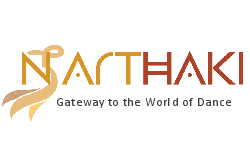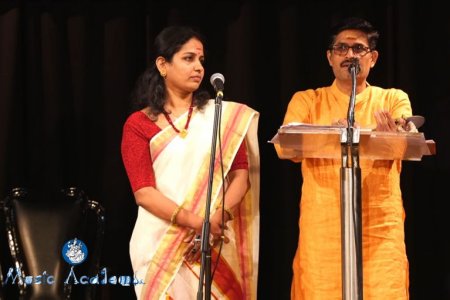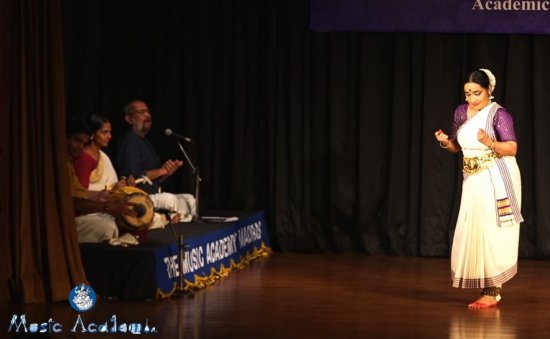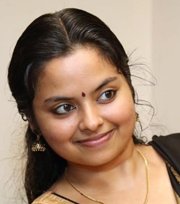
|   |

|   |
The Symphony of Emotions: Role of ragas in evoking rasas - Dr. Sreedevi N. Nampoothiri e-mail: sreedevi.nn@gmail.com February 7, 2025 This year’s Madras Music Academy conference featured lecture series on Raga, with two sessions focusing on the performance aspect and how bhava or rasa is communicated to the audience. The session with respect to Mohiniyattam was done by this year's Nritya Kalanidhi, Dr. Neena Prasad through her presentation “Evocative Expressions of Mohiniyattam using Carnatic Music” and that with respect to Kathakali was done by Nedumpally Ram Mohan and Meera Ram Mohan, accomplished artists in the field of Kathakali, through their lecture demonstration “The Abhinaya Sangeetham of Kathakali - The Blend of Raga and Bhava”. The discussions explored key factors influencing the emotional connection between a piece and its listeners. Raga is often linked to a specific emotion, with its structure shaped by notes, while its mood is influenced by rhythm, tempo, gamakas, and sthayis. These technical elements are skillfully used in performances to bring emotional drama to life, as highlighted in both discussions, supported by beautiful demonstrations. The role of rhythm Both lecture demonstrations provided detailed explanations of how the rhythmic flow of a song influences the raga bhava. Mohiniyattam, predominantly performed in vilamba and madhyama kala, allows ample space for the raga to unfold, showcasing its diverse hues and emotional nuances. The suddha nritta aspect and choreographic movements often serve as an undercurrent, subtly enhancing the emotional flow without disrupting it, creating a deeply musical experience. This distinguishes Mohiniyattam from Bharatanatyam, where the sruthi and theermanams sometimes create abrupt breaks in the emotional continuity of the performance. The graceful submissiveness of Mohiniyattam was beautifully exemplified through a Reethigowla Cholkettu and Kamakshi Swarajathi in Bhairavi, where the movements are intricately woven with the rhythmic flow, guiding the audience along with the undulating motions. In contrast, Kathakali's rhythmic patterns are vivid and dynamic, driven by percussion instruments such as the chenda and maddalam. In Kathakali, the rhythm and the music must align with the actor's body movements, mudras, and bhavas. While Mohiniyattam's movements are the primary focus for the rasika, Kathakali places greater emphasis on the vividness of the rhythm and percussion, which often dominate the performance. In Mohiniyattam, there is also repetition of sahithya, though in Kathakali, this repetition is more pronounced, with even a single syllable often sung over several rhythmic cycles. This extended repetition allows room for both the actor and singer to explore manodharma, enhancing the emotional depth of the performance. This feature was clearly demonstrated by Nedumbally Ram Mohan and Meera.  Nedumpally Ram Mohan and Meera Ram Mohan The role of tempo It's interesting to note that changes in tempo can significantly alter the mood of a performance. This technique is effectively used in both Mohiniyattam and Kathakali. A faster tempo typically conveys anger or veera rasa, while a slower tempo expresses sadness, helplessness, or romance. In Kathakali, the sahithya becomes denser when portraying anger or veera, with more words fitting within a given time frame. In contrast, for sringara or shoka rasa, the padas often feature longer aalapa sections with fewer words. Additionally, in Kathakali, the tempo for a given bhava is influenced by the nature of the character. For instance, the tempo used to express veera rasa in a Rajasa character differs from that used for a Thamasa character. Dr. Neena Prasad demonstrated how emotional shifts occur with changes in raga and tempo, particularly through her portrayal of Devayani’s life events. Ram Mohan and Meera also showcased diverse emotions, such as sringara, roudra, and veera, through varying tempos in their padams. Role of tonal variations The tonal variations and the emotions they convey were central to the discussions in both sessions. In the music of both art forms, major notes represent brighter emotions, while minor notes evoke feelings of sorrow and despair. Through the thematic representations of Panchali and Amrapali, Dr. Neena Prasad illustrated how the thoughtful selection of ragas and their tonal shifts evoke emotional changes. The use of higher and lower octaves is particularly effective in Kathakali sangeetham also, where the higher octaves amplify intense emotions like anger and loud cries, while the lower octaves express tenderness, sadness, and romance. In Kathakali, even non-musical notes take on a musical quality when paired with the alapana, a unique characteristic of this art form. Other factors Another interesting feature of Kathakali Sangeetham is the change in Adhara Sruthi to evoke specific emotions. When Adhara Shadja is shifted to Madhyama, the raga’s range alters, changing its emotive focus and completely transforming its structure and color. This technique is central to Kathakali music. Additionally, the pronunciation and stress placed on each word significantly influence the emotions conveyed, extending beyond the Alapana to the overall delivery. In contrast, in Mohiniyattam, the rendering style itself can induce mood shifts. While Kathakali musicians have more freedom to adapt music to the context, enhancing the drama and life of the performance, Mohiniyattam musicians follow a stricter adherence to the raga's structure. This flexibility in Kathakali allows any raga to express a wide range of emotions, even those seemingly unrelated to its traditional cultural associations. For instance, a Padam in Neelambari, typically a soft raga used for lullabies, was sung to evoke anger, demonstrating the versatility of Kathakali music. In Mohiniyattam, Carnatic ragas are used more rigidly, with the musician working within a defined structure to achieve the desired emotional effect. Also, in Kathakali the music rendering and percussion plays a crucial role in supporting the actor to bring different layers of an emotion whereas in Mohiniyattam, it's the subtle facial expressions, eye movements and subtle body movements that bring out the various layers of an emotion.  Dr.Neena Prasad Selection of ragas and artistic collaborations Dr. Neena Prasad highlighted the importance of carefully selecting a raga and rendering style during choreography. The musician's aesthetic sensibility is key to aligning the raga with the plot's primary and secondary emotions. The style of rendering also changes depending on the piece, with Suddha Nritta differing from Abhinaya. She emphasized that a dancer must possess both musical and rhythmic sensibility, along with expertise in dance, while a musician must have the aesthetic insight to grasp the essence of the piece. It is the collaboration between both that brings forth beautiful productions. In Kathakali, the raga used must complement the actor’s bhava, mudra and movements. With suitable examples, Ram Mohan and Meera demonstrated the usage of indigenous ragas such as Malama, Padi, Khandaram etc and also allied ragas like Shree and Madhyamavathi coming together enhancing the emotional depth of the plot. Nedumpally Ram Mohan emphasized that musicians and percussionists must also have knowledge in mudras, adavus etc., demonstrating the importance of aesthetic sensibility and collaborative effort among artistes to achieve the desired emotional impact. Both sessions led to engaging discussions on the role of Kala Pramana, tonal quality, and their influence on expressing emotions. The evolution and diverse use of ragas were explored, along with how social conditioning and cultural habitation shape art appreciation. The discussions also emphasized how human emotions, relationships, and shared experiences help bridge connections across cultures. Dr. Neena Prasad was ably supported throughout the presentation by veteran musician Changanassery Madhavan Nampoothiri on vocal, Ramesh Babu on mridangam, and Vidya Pradeep on the cymbals. Madhavan Nampoothiri composed the music for all items, except the Bhairavi Swarajathi, while Dr. Neena Prasad choreographed the pieces. Their collaboration resulted in a series of margams in various tala patterns and innovative thematic plays, greatly enriching Mohiniyattam and establishing it as a prominent art form. Nedumpally Ram Mohan and Meera Ram Mohan complemented each other throughout the lec-dem, with their soulful renditions leaving a lasting impact. Their beautiful demonstrations showcased their deep understanding of the art form, highlighting its richness and diversity.  Dr. Sreedevi N Nampoothiri is an Ayurvedic physician with a deep passion for classical art forms. She received foundational training in Mohiniyattam and Bharatanatyam during her school years and is currently furthering her expertise in Mohiniyattam under the guidance of Dr. Neena Prasad. |